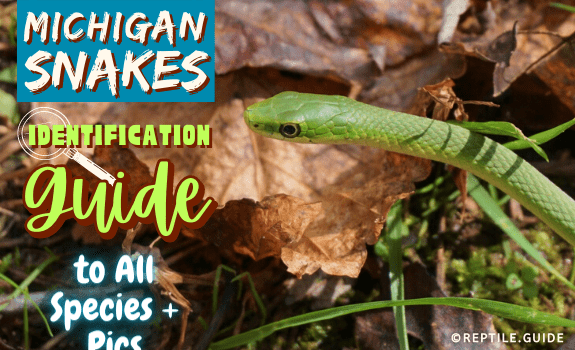Did you know that, despite its cold, unpredictable climate, Michigan is home to a whopping 18 snake species?
Rest assured, only one of those species poses any threat to humans.
Want to learn about the mystifying Eastern Massasauga Rattler – and Michigan’s other unique snake species?
You’ve come to the right place! We’ve compiled the ultimate guide for identifying the Great Lakes state’s snakes – including some great Michigan snakes images!
In This Article
In Short
- There are 18 species of snakes in Michigan.
- The most common snakes in Michigan are water snakes and garter snakes.
- Snakes play a critically important role in the ecosystem as predators and prey.
- Michigan is home to many iconic snakes, like Smooth Green Snakes and Queen Snakes.
- There’s only one venomous species in Michigan: the Eastern Massasauga Rattlesnake, an endangered species.
Snake Identification Basics
Correctly identifying Michigan’s native snake species requires equal helpings of studying and in-field experience.
There’s only one species that poses any threat to people, and luckily, it’s easy to distinguish from the state’s remaining 17 species.
Expert Tip: Taking a photo of snakes you encounter will help you practice your identification skills.
Compare them with our pictures of Michigan snakes to try and “guess the species” later on!
Venomous Snakes in Michigan
Are there any poisonous snakes in Michigan?
Technically, no! Poison is a toxin that is ingested, and none of the Michigan snakes are dangerous to eat. However…
There are venomous snakes in Michigan: Eastern Massasauga Rattlesnakes.
According to the Michigan Department of Natural Resources, this species is endangered and federally protected. Let’s learn how to identify it.
How to Identify the Only Venomous Snake in Michigan
It’s easy to identify Michigan’s only venomous serpent.
Eastern Massasauga Rattlesnakes are the only Michigan snakes with:
- Elliptical, cat-like pupils
- A rattle on the end of their tail
- Heat-sensing pits near their nostrils
Never rely on only one of these features for identification purposes – especially if there’s any chance the snake could bite you!
For example, some rattlesnakes lose their rattle. Similarly, a Massasauga’s pupils may dilate and look round, rather than elliptical, in darkness.
The Only Venomous Species in Michigan: The Eastern Massasauga Rattlesnake
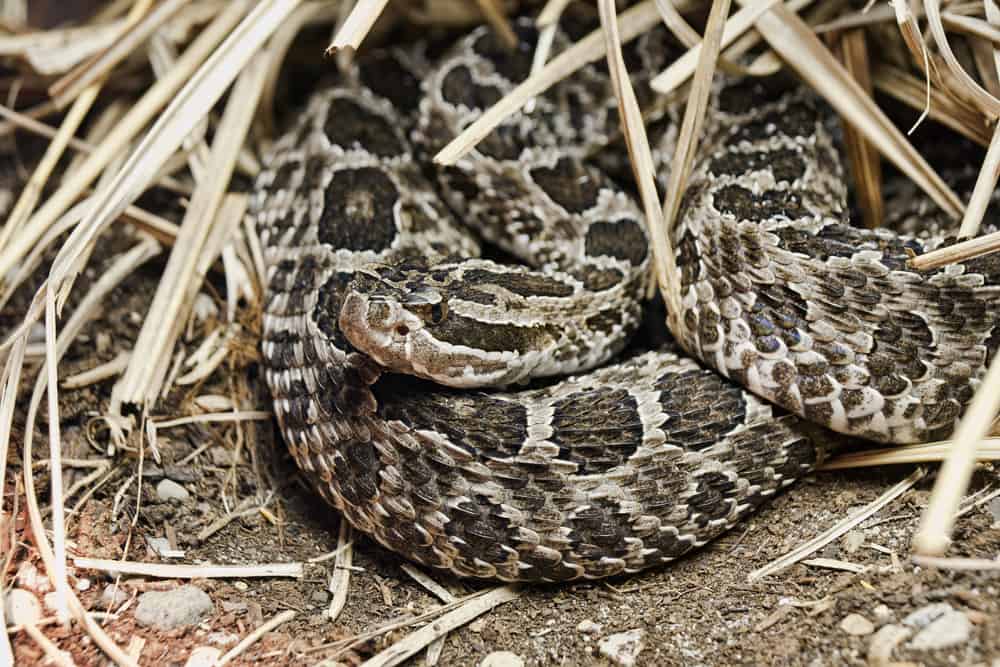
|
Scientific name: |
Sistrurus catenatus catenatus |
|---|---|
|
Range: |
Entire lower peninsula |
|
Size: |
18.5 – 39.5 in. |
|
Description: |
Thick, stout body Rough, keeled scales Elliptical, cat-like pupils Small, barely noticeable rattle at the end of their tail Some individuals may be melanistic (solid black) Black underside mottled with gray, yellow, or white Light gray or brown body with dark brown rectangular dorsal patches and two or three rows of spots on each side |
|
Habitat: |
Damp, lowland areas |
|
Status: |
Rare Federal status: Threatened species Michigan State Status: Special Concern Michigan Department of Natural Resources (MDNR) Wildlife Action Plan Status: Species of Greatest Conservation Need |
|
May be confused with: |
Eastern hog-nosed snake – lacks rattle, heat-sensing pits, and elliptical pupils |
|
Venomous/non-venomous: |
Venomous |
Fun Fact: Eastern Massasauga Rattlesnakes, like all other pit vipers, give birth to live young.
Types of Snakes in Michigan
What are the other 17 types of snakes in Michigan?
- Two species belong to the genus Storeria
- Two species belong to the genus Nerodia, water snakes
- Three species belong to the genus Pantherophis, rat snakes
- Three species belong to the genus Thamnophis, garter snakes
- The remaining seven species each belong to a unique type and genus
Common Snakes in Michigan
Arguably, the most common snakes here are Michigan water snakes and garter snakes.
The water snakes and garter snakes of Michigan typically live in or near aquatic habitats – which the state has an abundance of.
Gray rat snakes are a close runner up, while their cousins, the fox snakes, have dwindling populations. We’ll learn more about them later on.
Michigan Water Snakes
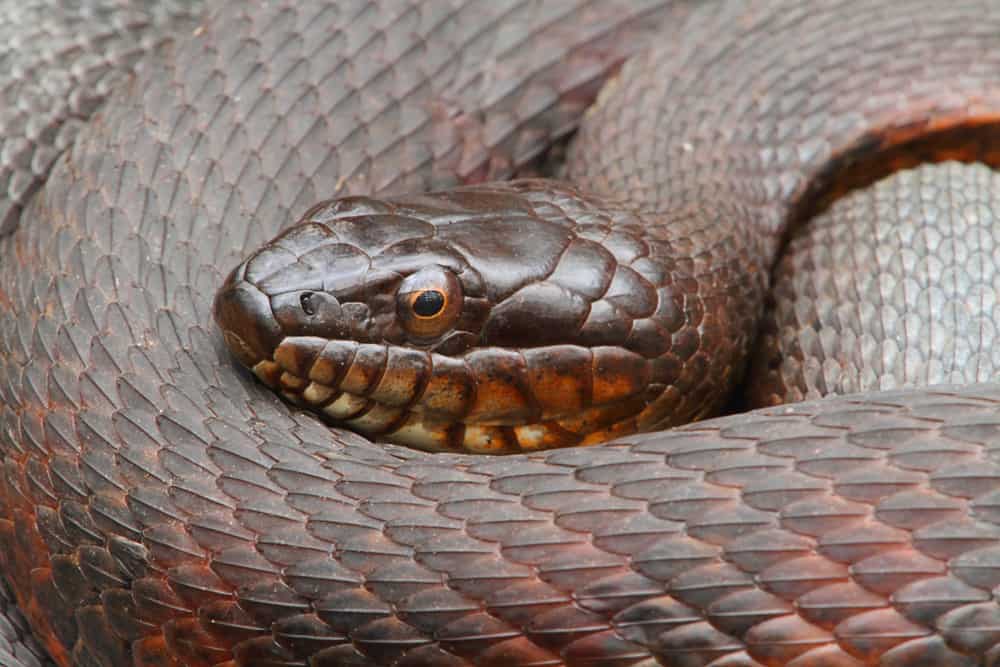
|
Scientific name: |
Nerodia sipedon sipedon (Northern Water Snake) Nerodia erythrogaster neglecta (Copper-Bellied Water Snake) |
|---|---|
|
Range: |
N. sipedon sipedon – Statewide, except the northwesternmost portion of the upper peninsula N. erythrogaster neglecta – Isolated populations in the southcentral region of the lower peninsula |
|
Size: |
24 – 56 in. |
|
Description: |
Large-bodied snakes Rough, keeled scales N. sipedon sipedon – Pattern fades on older animals – may appear uniformly black or brown Tan, brown, or gray body with black or brown crossbands and blotches on back and sides Off-white or orangish underside with a pattern of brown half-moon marks, with or without speckling N. erythrogaster neglecta: Mouth, chin, and underside are solid orange to red Uniform black, gray, or brown body with or without a faint blotched pattern |
|
Habitat: |
Permanent bodies of water with access to woodlands and sunny basking spots |
|
Status: |
N. sipedon sipedon: Abundant N. erythrogaster neglecta: Rare, isolated populations Michigan State Status: Endangered MDNR Wildlife Action Plan Status: Species of Greatest Conservation Need |
|
Venomous/non-venomous: |
Non-venomous |
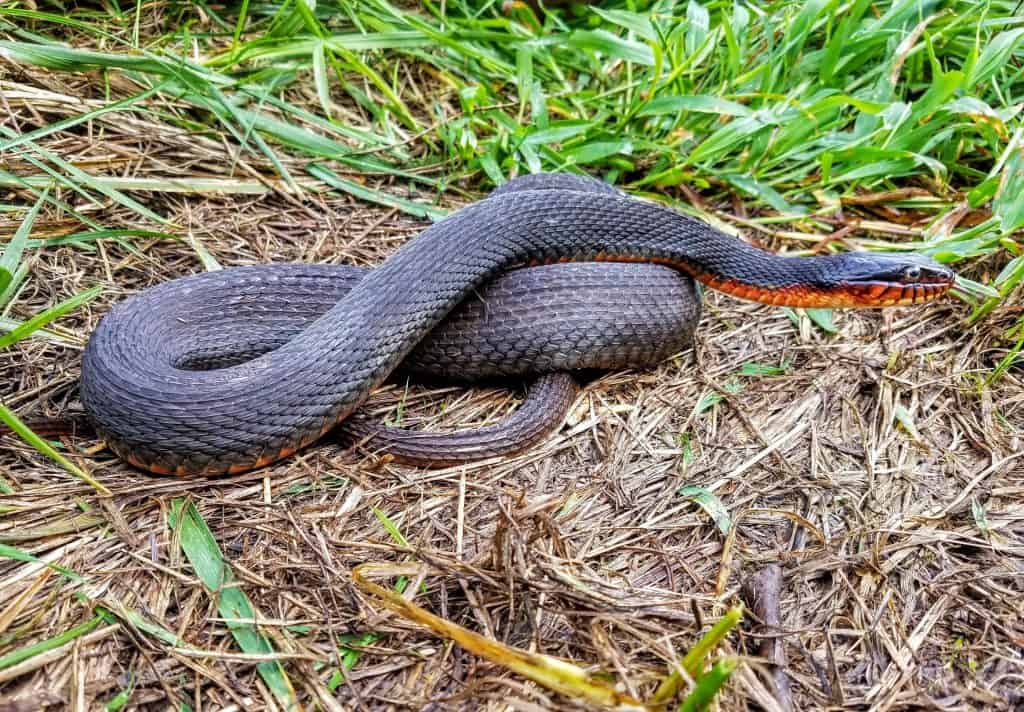
Image Credit: u/H0rridus (via Reddit.com)
Michigan Garter Snakes
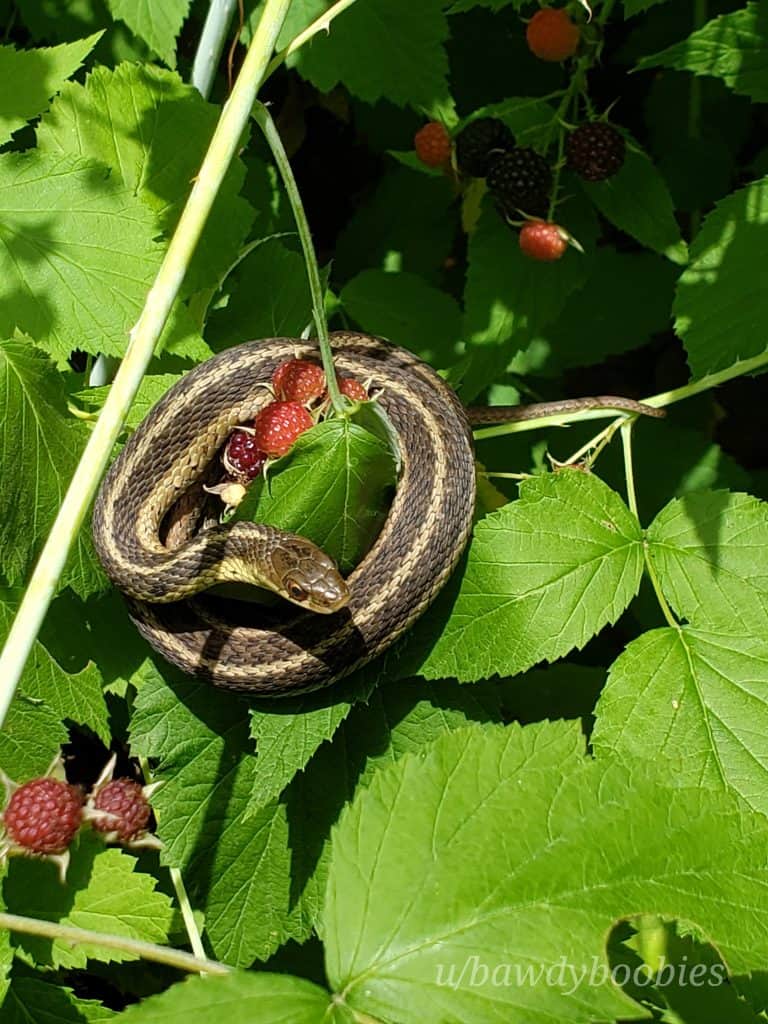
Image Credit: u/bawdyboobies (via Reddit.com)
The Eastern Garter Snake species and the Northern Ribbon Snake species are the most common in Michigan, while the Butler’s Garter Snake is a species of special concern.
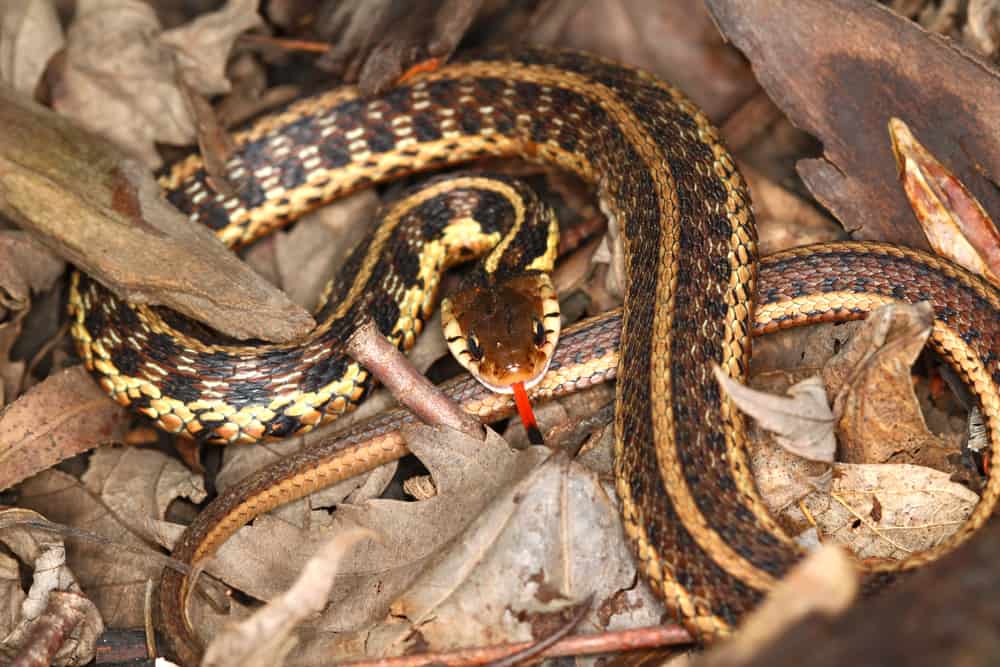
|
Scientific name: |
Thamnophis butleri (Butler’s Garter Snake) Thamnophis sirtalis sirtalis (Eastern Garter Snake) Thamnophis sauritus septentrionalis (Northern Ribbon Snake) |
|---|---|
|
Range: |
T. butleri: Eastern ⅔ of the lower peninsula T. sirtalis sirtalis: Statewide T. sauritus septentrionalis: Entire lower peninsula |
|
Size: |
T. butleri: 15 – 29 in. T. sirtalis sirtalis: 18 – 54 in. T. sauritus septentrionalis: 6.5 – 9.5 in. |
|
Description: |
Large eyes Rough, keeled scales Small to medium, slender snakes T. butleri: Two small yellow spots on back of head Mouth and underside are yellow or pale green, with or without spotting Black, brown, or olive body with three prominent yellow or orange lengthwise stripes May have two rows of spots between the stripes T. sirtalis sirtalis: Some individuals may be melanistic Significant color variation in this snake species Underside and mouth are yellow, green, pale blue, tan, or white with or without spotting Black, brown, gray, or olive body with three light-colored yellow, green, brown, bluish, or white lengthwise stripes Checkerboard pattern between stripes T. sauritus septentrionalis: Most slender Thamnophis species Underside is solid green, yellow, or white Dark brown or black body with three yellow or white lengthwise stripes |
|
Habitat: |
Moist, grassy areas with abundant fish populations Frequently inhabits urban and suburban areas |
|
Status: |
T. butleri: Michigan State Status: Special Concern MDNR Wildlife Action Plan Status: Species of Greatest Conservation Need T. sirtalis sirtalis: Abundant T. sauritus septentrionalis: Abundant |
|
Venomous/non-venomous: |
Mildly venomous (not dangerous to humans) |
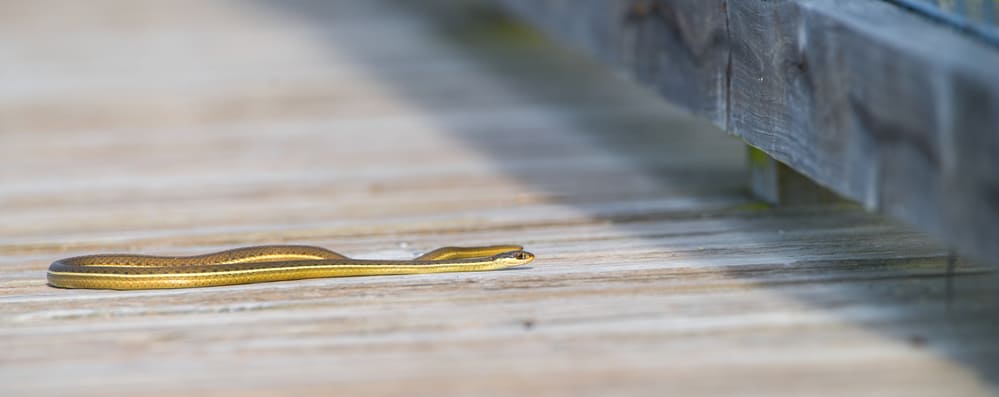
Iconic Michigan Snake Species
There are a handful of popular, viral, or otherwise well-known Michigan snake species, including the:
- Blue Racer
- Smooth Green Snake
- Eastern Hog-Nosed Snake
Keep reading to find out why these snakes are so famous!
Blue Racer
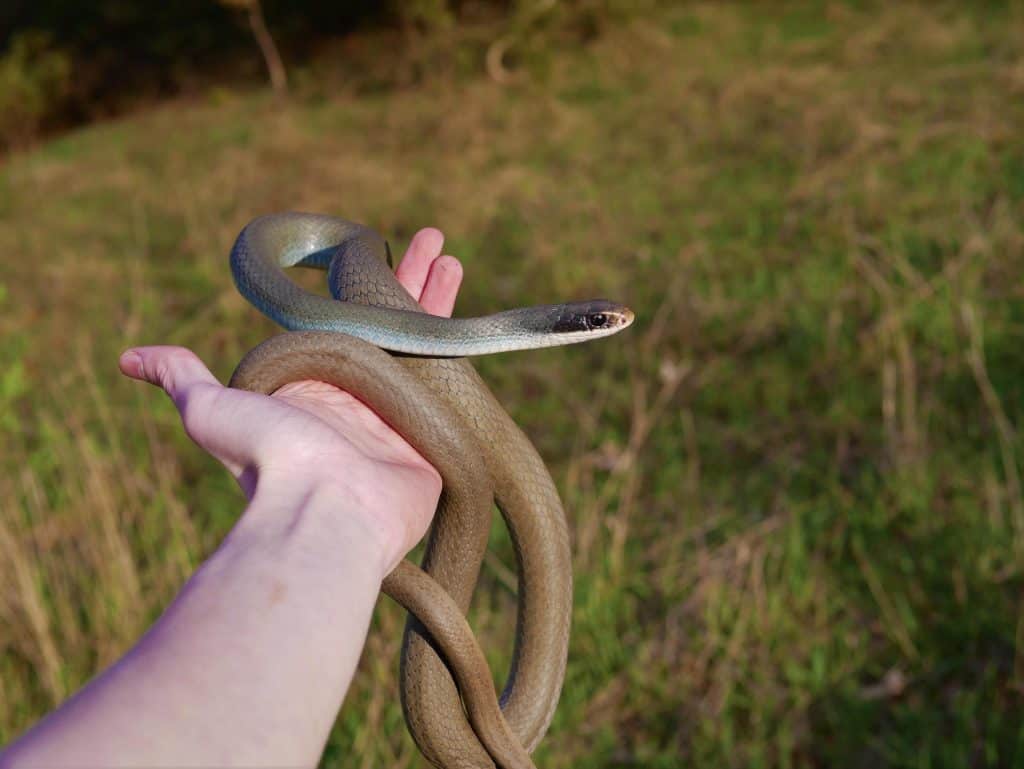
Image Credit: u/mothingitright (via Reddit.com)
Did you know snakes could be BLUE?! Meet Michigan’s enigmatic Blue Racer.
|
Scientific name: |
Coluber constrictor foxi |
|---|---|
|
Range: |
Southern ⅔ of the lower peninsula |
|
Size: |
35 – 75 in. |
|
Description: |
Long, slender snake Bluish or off-white underside Large eyes with pronounced brow ridges Smooth, unkeeled scales with a shiny appearance Uniform gray, blue-gray, turquoise, olive, or brown body |
|
Habitat: |
Dry, sunny habitats |
|
Status: |
Common, declining populations MDNR Wildlife Action Plan Status: Species of Greatest Conservation Need |
|
Venomous/non-venomous: |
Non-venomous |
Smooth Green Snake
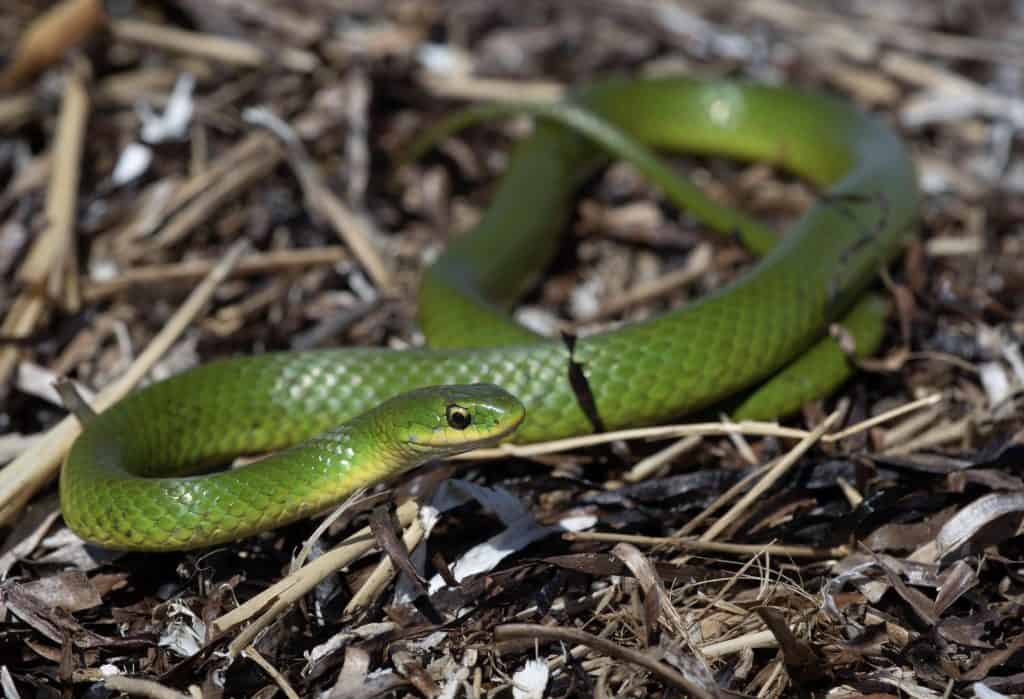
Image Credit: u/justaguest12 (via Reddit.com)
First a blue snake… now green?! Clearly, Michigan is home to a rainbow’s array of colorful serpents. Identifying these emerald beauties is fairly straightforward, but just in case…
|
Scientific name: |
Opheodrys vernalis |
|---|---|
|
Range: |
Entire upper peninsula, scattered populations on the north, east, and west sides of the lower peninsula |
|
Size: |
12 – 26” |
|
Description: |
Small, slender snake Smooth, unkeeled scales Head slightly wider than neck Underside and mouth are yellow or white Body is bright green, or sometimes brown, tan, or bronze Body turns blue shortly after death |
|
Habitat: |
Moist, grassy habitats |
|
Status: |
Declining populations Michigan State Status: Special Concern MDNR Wildlife Action Plan Status: Species of Greatest Conservation Need |
|
Venomous/non-venomous: |
Non-venomous |
Eastern Hog-Nosed Snake
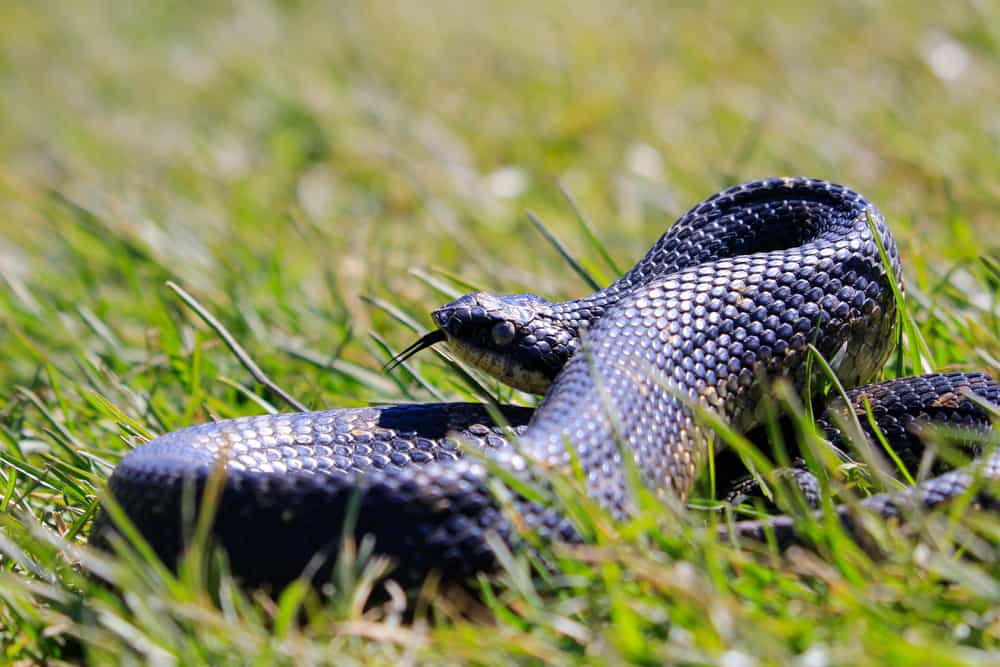
Hog-Nosed Snakes are known amongst the reptile community as the drama queens of the snake world.
If you’re hoping to witness their infamous cobra impressions and death-feigning antics first-hand, you’ll have to learn to identify them first.
|
Scientific name: |
Heterodon platirhinos |
|---|---|
|
Range: |
Entire lower peninsula |
|
Size: |
20 – 45.5 in. |
|
Description: |
Thick-bodied snake Rough, keeled scales Upturned rostral (nose) scale Some individuals may be melanistic Underside yellow, off-white, or pinkish with dark mottling Large head, occasionally flattened (cobra-like) neck Gray, brown, tan, olive, orange, yellow, black, or pinkish body with or without dark blotches and spots |
|
Habitat: |
Virtually all terrestrial Michigan habitats |
|
Status: |
Common in undisturbed habitats MDNR Wildlife Action Plan Status: Species of Greatest Conservation Need |
|
Venomous/Non-Venomous: |
Mildly venomous (not dangerous to humans) |
Other Snakes Native to Michigan
Of course, there are many more elusive and underrated snakes native to Michigan.
From the widespread queen snake species to the odd milk snake of Michigan, keep reading to learn more about these cool critters.
Brown Snake
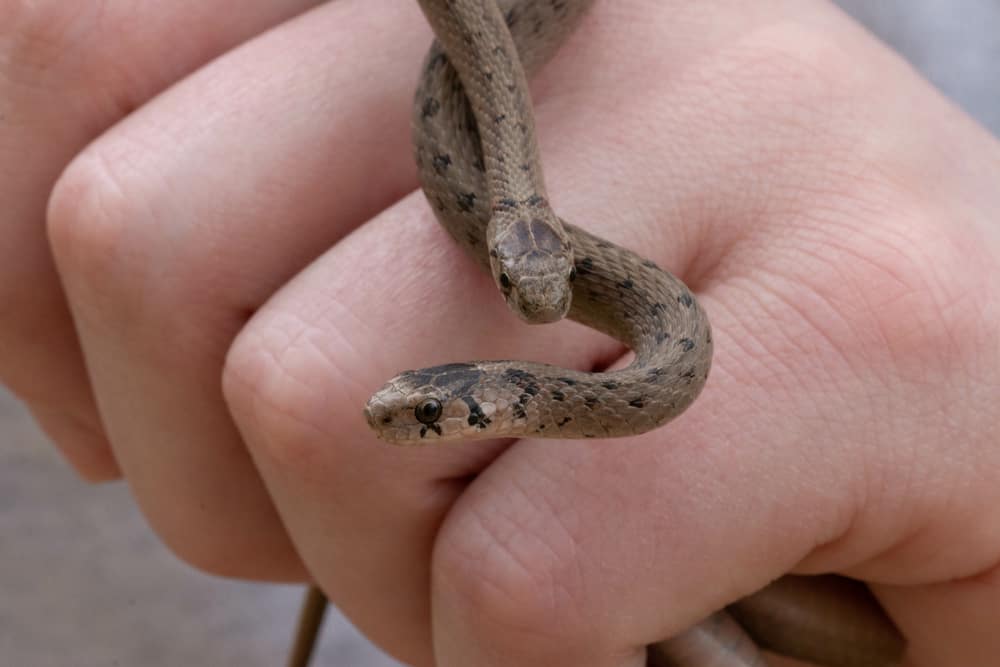
|
Scientific name: |
Storeria dekayi dekayi |
|---|---|
|
Range: |
Entire lower peninsula and southern parts of the upper peninsula |
|
Size: |
9 – 21” |
|
Description: |
Tiny snake Small head Rough, keeled scales Brown, gray, or tan body with a light brown dorsal stripe that’s bordered on each side by dark brown spots |
|
Habitat: |
Habitats with moist soil Frequently inhabits agricultural, suburban, and urban areas |
|
Status: |
Common |
|
Venomous/non-venomous: |
Non-venomous |
Queen Snake
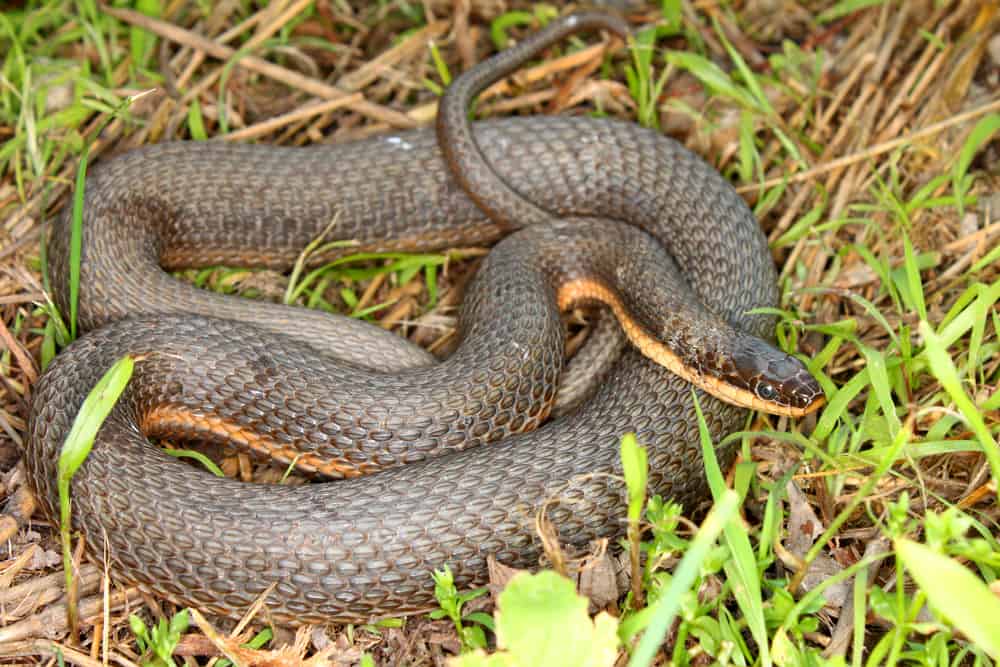
|
Scientific name: |
Regina septemvittata |
|---|---|
|
Range: |
Southern ⅔ of the lower peninsula |
|
Size: |
13.5 – 36.5 in. |
|
Description: |
Small, slender snake Rough, keeled scales Off-white, striped underside Head slightly wider than neck Old adults may become uniformly black or dark olive Brown, olive, or gray body with white or yellow stripe on each side of the body |
|
Habitat: |
Shallow, rocky-bottomed bodies of water with healthy crayfish populations |
|
Status: |
Declining populations Michigan State Status: Special Concern MDNR Wildlife Action Plan Status: Species of Greatest Conservation Need |
|
Venomous/non-venomous: |
Non-venomous |
Gray Rat Snake
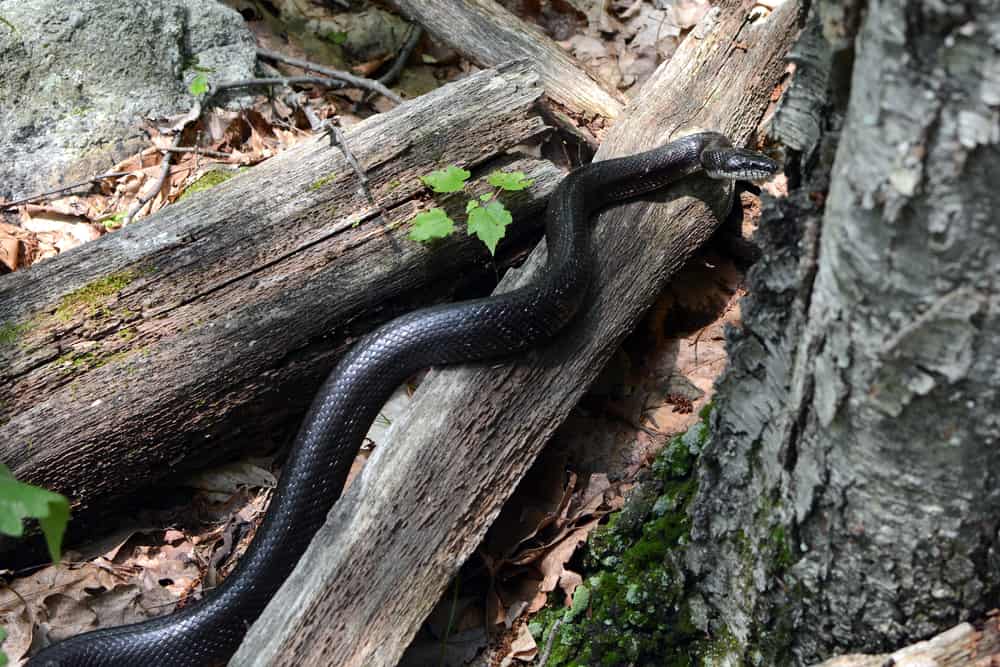
|
Scientific name: |
Pantherophis obsoleta obsoleta |
|---|---|
|
Range: |
Southern half of the lower peninsula |
|
Size: |
40 – 101 in. |
|
Description: |
Largest snake in Michigan Slightly keeled, rough scales Juveniles have a blotched pattern White underside with checkerboard pattern Adults have uniform black or dark brown body with or without white, yellow, or orange flecking |
|
Habitat: |
Open habitats with adjacent woodlands Frequently inhabits suburban areas |
|
Status: |
Uncommon to rare Michigan State Status: Special Concern MDNR Wildlife Action Plan Status: Species of Greatest Conservation Need |
|
Venomous/non-venomous: |
Non-venomous |
Kirtland’s Snake
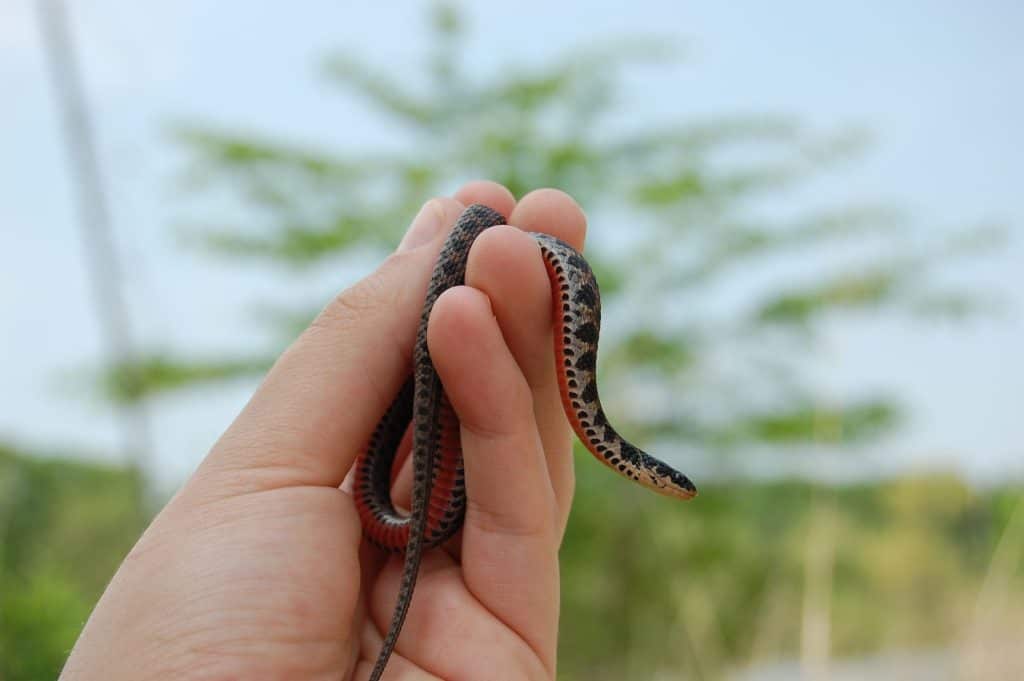
Image Credit: u/EmeraldGirl (via Reddit.com)
|
Scientific name: |
Clonophis kirtlandii |
|---|---|
|
Range: |
Southernmost regions of the lower peninsula |
|
Size: |
14 – 24.5 in. |
|
Description: |
Medium-bodied snake Rough, keeled scales Small head, sometimes with a mottled pattern Characteristic pink, orange, or red underside Red- to gray-brown body with four rows of alternating round, dark blotches along the back and sides Markings may fade with age |
|
Habitat: |
Moist, grassy habitats |
|
Status: |
Rare Michigan State Status: Endangered MDNR Wildlife Action Plan Status: Species of Greatest Conservation Need |
|
Venomous/non-venomous: |
Non-venomous |
Eastern Milk Snake
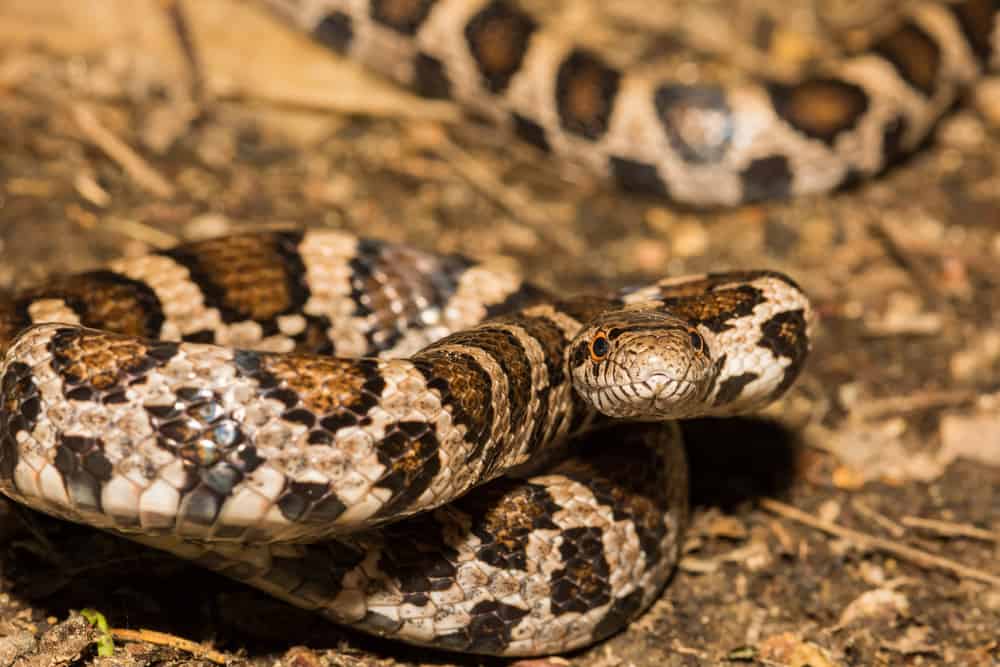
|
Scientific name: |
Lampropeltis triangulum triangulum |
|---|---|
|
Range: |
Entire lower peninsula and eastern tip of upper peninsula |
|
Size: |
24 – 52 in. |
|
Description: |
Slender, small snake Smooth, unkeeled scales Y- or V-shaped mark on back of head Off-white underside with irregular checkerboard pattern Gray or tan body with reddish-brown saddles that are outlined in black |
|
Habitat: |
Virtually all terrestrial Michigan habitats Frequently inhabits suburban areas |
|
Status: |
Common |
|
Venomous/non-venomous: |
Non-venomous |
Northern Red-Bellied Snake
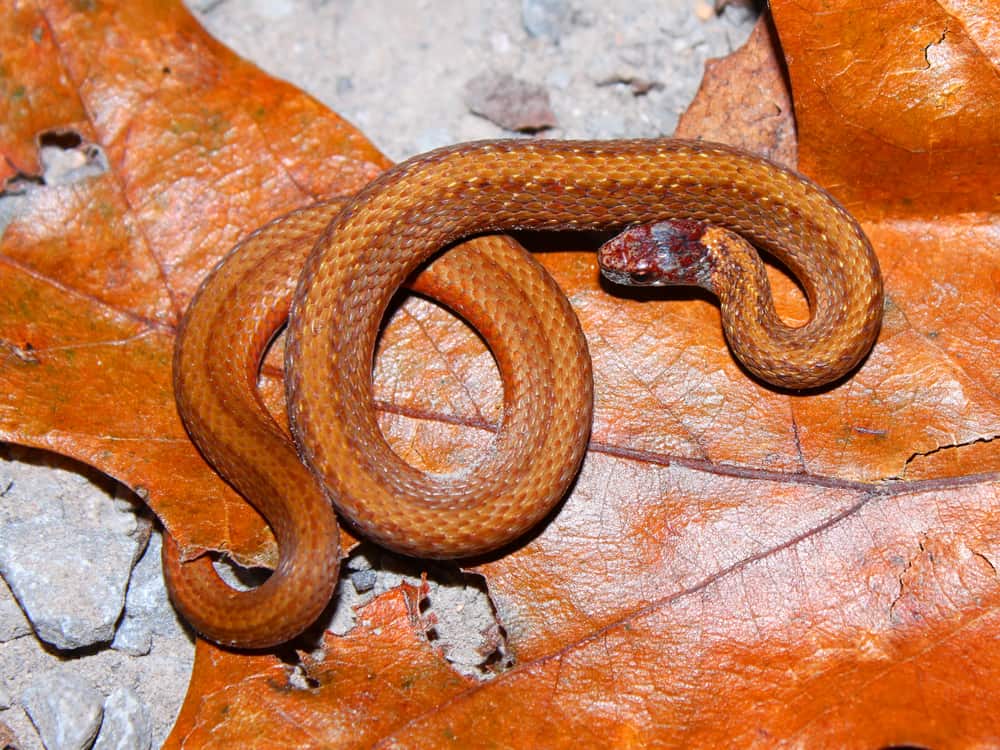
|
Scientific name: |
Storeria occipitomaculata occipitomaculata |
|---|---|
|
Range: |
Statewide except the southernmost regions of the lower peninsula |
|
Size: |
8 – 16 in. |
|
Description: |
Tiny, slender snakes Bright red or orange underside Uniform reddish-brown or gray body May have two to four thin, dark stripes along the length of their back |
|
Habitat: |
Habitats with moist soil, open areas, and woodlands Sometimes inhabits urban and suburban areas |
|
Status: |
Common |
|
Venomous/non-venomous: |
Non-venomous |
Northern Ring-Necked Snake
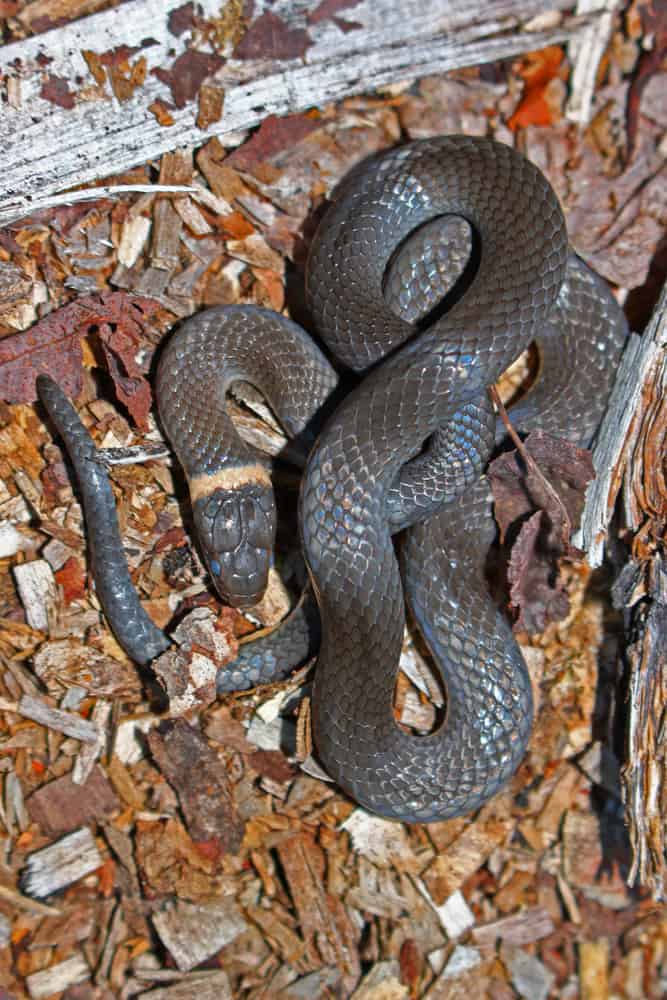
|
Scientific name: |
Diadophis punctatus edwardsii |
|---|---|
|
Range: |
Statewide |
|
Size: |
10 – 27.5 in. |
|
Description: |
Tiny, slender-bodied snake Orange or yellow underside Smooth, shiny, unkeeled scales Solid black, gray, or brown body Distinctive orange or yellow ring around their neck |
|
Habitat: |
Moist, shaded woodlands, and adjacent habitats |
|
Status: |
Secretive Common to rare, depending on region MDNR Wildlife Action Plan Status: Species of Greatest Conservation Need |
|
Venomous/non-venomous: |
Non-venomous |
Western and Eastern Fox Snakes
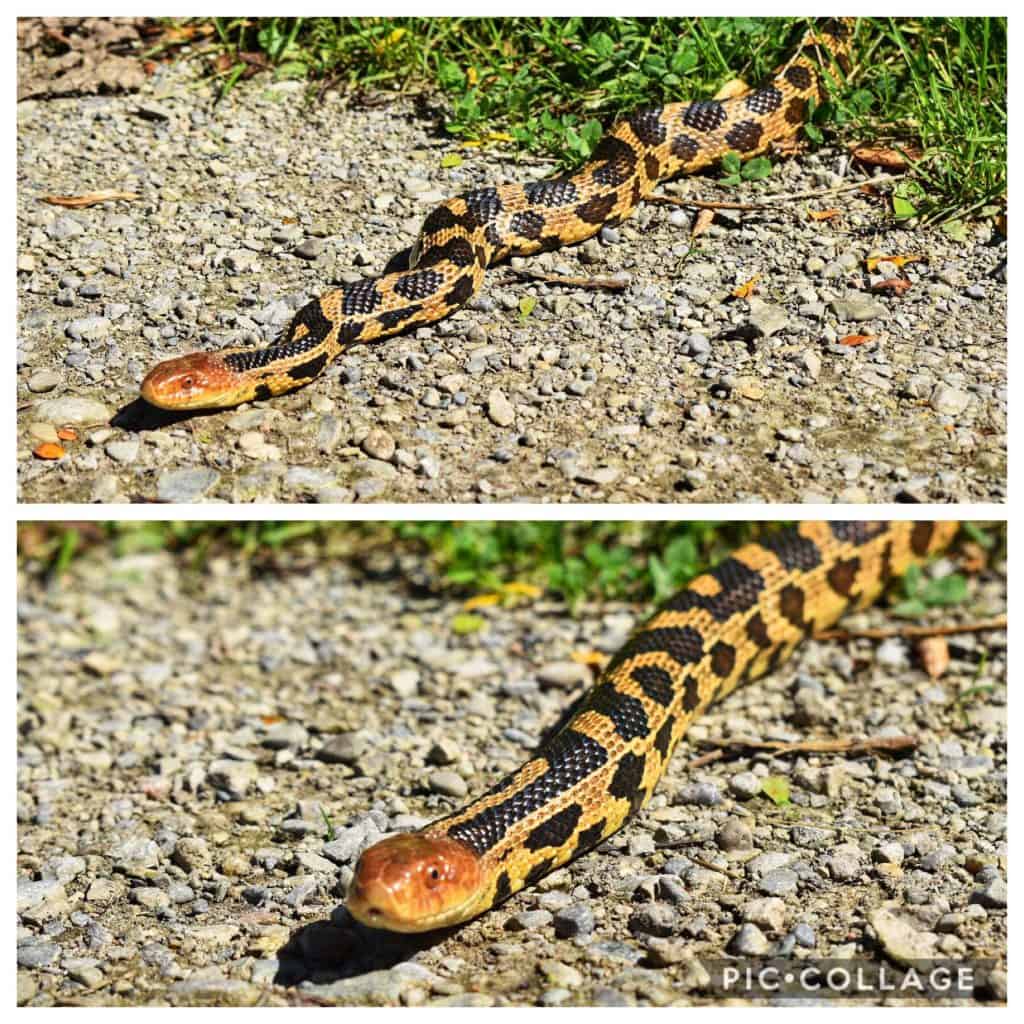
Image Credit: u/stumblingzen (via Reddit.com)
|
Scientific name: |
Pantherophis gloydi (Eastern Fox Snake) Pantherophis vulpina (Western Fox Snake) |
|---|---|
|
Range: |
P. gloydi: southeastern lower peninsula P. vulpina: western half of the upper peninsula |
|
Size: |
35.5 – 61 in. |
|
Description: |
Rough, keeled scales Large, heavy-bodied snakes Off-white underside with square-shaped markings Yellowish- or grayish-brown body with brown or black blotches Yellow, red, brown, or orange broad heads with stripe between eyes |
|
Habitat: |
P. gloydi: Grassy shoreline habitats P. vulpina: Open, grassy habitats |
|
Status: |
Common to rare, depending on species and region P. gloydi: Michigan State Status: Threatened species MDNR Wildlife Action Plan Status: Species of Greatest Conservation Need |
|
Venomous/non-venomous: |
Non-venomous |
What You Need to Know
While tropical Florida is home to over 60 lizard species and nearly 50 snake species, chilly Michigan probably doesn’t seem like it’d make an ideal home state for reptiles.
The truth is that many snake species thrive in the abundant wetlands – so much so that they’ve even evolved to survive Michigan’s harsh winters!
If you’re an outdoors enthusiast in Michigan, you’re bound to come across one of these snakes eventually.
Remember to stay calm. The only venomous snake in Michigan is so rare that you should consider yourself lucky if you encounter one!
All snakes in Michigan play vital and beneficial roles in the ecosystem.
They serve as an essential food source for predators, such as birds of prey and foxes.
Perhaps even more importantly, some snakes consume rodent or insect pests, keeping their populations in check.
Coexisting With Michigan Snakes
If you encounter a snake in Michigan, we encourage you to admire it from a safe distance and maybe even try to figure out the snake species!
Unless absolutely necessary, refrain from handling wild snakes, or any Michigan wildlife. Remember that some snakes are protected by law, and others could put you in the hospital!
The best way to coexist with Michigan’s snakes is by treating them with respect and admiration and without fear or disgust.
Snake Safety 101
The first and most important rule of snake safety is to keep your distance and avoid handling wild snakes unnecessarily.
If there’s an unwanted, perhaps venomous, snake on your property, you have three options:
- Ignore it – The snake will eventually leave manicured yards in search of food, water, and adequate shelter.
- Call a professional – There are snake removal professionals across the country, including in Michigan. For more information, check out the “Useful Resources” section.
- Encourage it to leave – You can encourage wild snakes to leave your property by gently spraying them with a water hose.
Remember that snakes are an integral part of our ecosystem and don’t want to harm you. Harassing or injuring some snake species can even result in a fine – or jail time!
In the rare event that a venomous Massasauga Rattlesnake bites you:
- Stay calm and move as little as possible.
- Call 911 or get the victim to a hospital as soon as possible.
- Remove any tight clothing or jewelry before swelling occurs.
- Don’t attempt any treatment yourself. Wait for a professional.
- Raise the bite above heart level to slow the distribution of venom.
- Remember as many details about the snake as you can. Take a picture of the snake if possible. A proper ID is essential for receiving the correct antivenom.
Useful Resources
If a rattlesnake bites you or someone you’re helping, contact the Michigan Poison Center at (800) 222-1222.
They’ll direct you to a local medical facility that can appropriately treat snake envenomations.
If a rattlesnake bites your pet, immediately take your furry friend to your local emergency veterinary hospital.
You can also contact the ASPCA Animal Poison Control Center at (888) 426-4435.
If you need a snake removed from your property, check out this Facebook group for a free snake relocation directory.
You can find out more about Michigan’s snakes, and other wildlife, on their Department of Natural Resources website.
We hope you have some great knowledge about the snakes of Alabama now. Find out more articles about the snakes of Hawaii, South Carolina, California, Arizona, Pennsylvania, Florida, Missouri, Georgia, Virginia, Tennessee here.
